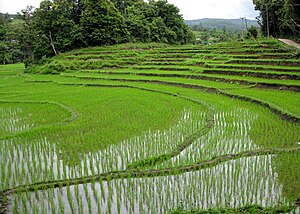Rice production in Thailand
Thailand has a strong tradition of rice production. It has the fifth-largest amount of land under rice cultivation in the world and is the world's second largest exporter of rice. Thailand has plans to further increase its land available for rice production, with a goal of adding 500,000 hectares to its already 9.2 million hectares of rice-growing areas. The Thai Ministry of Agriculture expects rice production to yield around 30 million tons of rice for 2008. The most produced strain of rice in Thailand is jasmine rice, which is a higher quality type of rice. However, jasmine has a significantly lower yield rate than other types of rice, but it also normally fetches more than double the price of other strains in a global market.
 The government wanted to promote urban growth and one of the ways it accomplished this was by taxing the rice industry and using the money in big cities.In fact, during 1953, tax on rice accounted for 32 percent of government revenue. The government set a monopoly price on exports, which increased tax revenue and keep domestic prices low for Thailand. The overall effect was a type of income transfer from farmers to the government and to urban consumers (who purchased rice). These policies on rice were called the "rice premium," which was used until 1985 when the government finally gave into political pressure. The shift away from protecting the peasant rice farmers by the government moved the rice industry away from the egalitarian values that were enjoyed by farmers to more of a modern-day, commercial, profit-maximizing industry.
The government wanted to promote urban growth and one of the ways it accomplished this was by taxing the rice industry and using the money in big cities.In fact, during 1953, tax on rice accounted for 32 percent of government revenue. The government set a monopoly price on exports, which increased tax revenue and keep domestic prices low for Thailand. The overall effect was a type of income transfer from farmers to the government and to urban consumers (who purchased rice). These policies on rice were called the "rice premium," which was used until 1985 when the government finally gave into political pressure. The shift away from protecting the peasant rice farmers by the government moved the rice industry away from the egalitarian values that were enjoyed by farmers to more of a modern-day, commercial, profit-maximizing industry.
The Thai government had strong incentives to increase rice production and they were successful in most of their plans. The government invested in irrigation, infrastructure, and other pro-rice projects. The World Bank also provided finance for dams, canals, locks, ditches, and otherinfrastructure in the Greater Chaophraya Project. These policies helped lead rice land to increase from 35 million to 59 million rai from 1950s to 1980s. The graph on the next page, Figure 2, shows the increased paddy rice production in Thailand from 1961 to 2007. The rice production has about tripled in terms of total paddy rice produced. While Thailand's rice production has not increased every year, which is not to be expected, one can see a trend line for steady significant increases since the 1960s.

ไม่มีความคิดเห็น:
แสดงความคิดเห็น